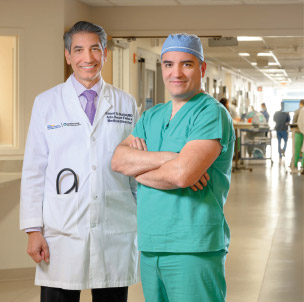When David Johnson learned he needed a Left Ventricular Assist Device (LVAD), the Baltimore County resident traveled to the nation’s capital—40 miles and seemingly a world away—despite the presence of two LVAD/heart transplant sites right in his own backyard.
His destination was MedStar Washington Hospital Center, home to the MedStar Heart & Vascular Institute (MHVI), by far the most accomplished VAD site in the region. His journey marked the mid-point of several years of planning to build a seamless Advanced Heart Failure (AHF) system spanning the two cities.
“We have a big footprint in Baltimore,” says Samer Najjar, MD, director of MedStar Health’s Advanced Heart Failure Program. “Our goal from the beginning was to figure out how to serve all AHF patients in the system equally well, including those needing VADs or transplant.”
The AHF teams in both cities put their heads together to create a program that could fully integrate their services.
Design, Diligence, Dedication

(l to r) MHVI’s Advanced Heart Failure Program Director Samer Najjar, MD, and Surgical Director Ezequiel Molina, MD
The foundation for such a program was already in place. MedStar Washington Hospital Center ranks among U.S. News & World Report’s top 50 cardiovascular programs in the United States, and as the best heart hospital in the Washington, D.C., region. MedStar Union Memorial Hospital has been included among the top 100 heart hospitals nationwide, with a long history as a tertiary referral center for the Baltimore area. Both are allied with the Cleveland Clinic Heart and Vascular Institute, sharing a rigorous commitment to quality and safety, with impressive outcomes as testimonial.
The two hospitals’ services also practically mirror each other, with one important difference. Only the Hospital Center performs the two most highly sophisticated surgical AHF procedures available—LVAD implantation and heart transplantation. In fact, it is one of the most experienced VAD sites in the nation, implanting more than 80 devices each year. Its growing transplant program, the first in Washtington, D.C., performs more than 16 of these vital operations annually, on par with other major centers.
The biggest question, then, became how to bring the pinnacle standard of care to Baltimore’s sickest AHF patients, with as little disruption to their daily lives and routines as possible.
Building Beyond Referrals
The answer lay in establishing a secondary MHVI hub in Baltimore with a seamless expressway between the two cities.
Four years ago, the specialists at MedStar’s Union Memorial and Good Samaritan hospitals—were tasked with the challenge.
MedStar Health has the most mature, sophisticated AHF program around, with a history of providing aggressive yet thoughtful care, and a renowned VAD program. Their goal was to replicate that approach for the residents of Baltimore, without duplicating the mechanical assist or transplant services, both of which require a huge amount of infrastructure.”
Toward that end, MedStar Union Memorial hired Sandeep Mahendra Jani, MD, MPH, a former fellow at MedStar Washington Hospital Center, to serve as associate director of Advanced Heart Failure for MHVI’s Baltimore region. Dr. Jani specializes in identifying and treating patients with hypertrophic cardiomyopathy, LVAD management, and transplantation cardiology at both MedStar Union and MedStar Franklin Square Medical Center.
To strengthen ties and familiarity between the Baltimore and Washington teams, cardiologists from MedStar Union Memorial Hospital rotate through the Hospital Center. In January 2018, MedStar Union Memorial formalized a VAD clinic to assist with post-LVAD routine follow-up care in Baltimore.
The result is a much smoother, easier experience for patients. MedStar Union Memorial is providing the highest level of medical care available—including intravenous inotropic agents—to AHF patients in Baltimore. But when medications fail, they can then conduct a complete work-up of potential VAD/transplant patients right in their own facility.
Proof in Numbers
Thanks to the new program, over the past few years 32 patients from Baltimore have had VADs implanted, five of whom have transitioned to transplant, including David Johnson.
It’s been a tremendous effort, involving a multidisciplinary team of specialized physicians and nurses, intensivists and pharmacists, nutritionists and physical therapists, coordinators and social workers, ethicists and more, across two cities and two hospitals. The result is one seamless AHF program.
And that’s worth it, concludes Dr. Najjar.
“Throughout MHVI, we have a passion for patients and for returning some of those abilities that AHF has taken away,” he says. “Based upon this success, we hope to extend the new model throughout our MedStar system in the near future.”









